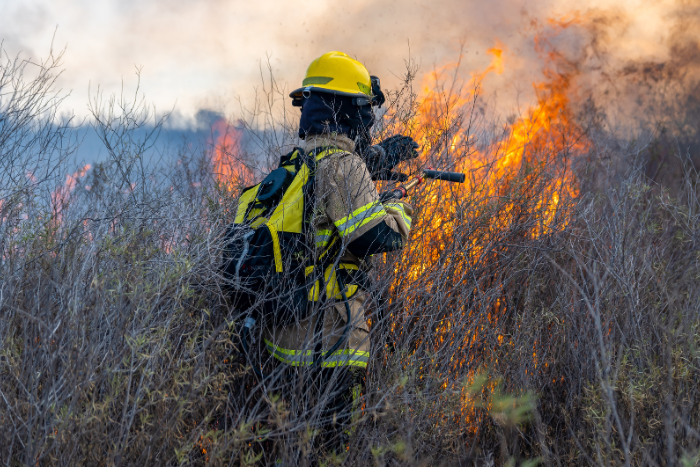Hot, dry and windy conditions that drove the wildfires in wetlands were made 40% more intense due to human-caused climate change, the study says
Human-caused climate change made the hot, dry and windy conditions that drove the catastrophic Pantanal wildfires in western Brazil during June about 40% more intense and 4-5 times more likely, a rapid analysis by a team of scientists has found.
The Brazilian Pantanal is experiencing a devastating wildfire season. More than 1.2 million hectares (12,000km²) are believed to have burned – around 8% of the Brazilian Pantanal biome, nearly half the size of Belgium.
The study by World Weather Attribution highlighted the urgent need to replace fossil fuels with renewable energy, reduce deforestation and strengthen bans on controlled burns to tackle the impact of wildfires on wildlife, indigenous communities and farmers.
(a) Map of June 2024 DSR anomaly over the study region wrt 1990-2020 June climatology (ERA5), showing active fire pixels as red dots. (b) accumulated annual mean rainfall vs annual mean of daily maximum temperatures over the last 45 years showing the drying and warming trend in different decades as well as the record in 2024.
Pantanal: The world’s largest tropical wetland
Located at the border with Bolivia and Paraguay, the Brazilian Pantanal— the world’s largest tropical wetland— comprises more than 15 million hectares. The wetland floods seasonally, from November to April, then drains in the dry season from May to October. It holds a huge range of unique species, is home to many indigenous groups, provides important ecosystem services for the surrounding area, supports the livelihoods of tens of thousands of ranchers, farmers and fishers, and is a vast carbon store.
Indigenous and traditional communities are among the worst affected by the wildfires, as traditional lands are destroyed, cultural practices disrupted and people displaced. Economic activities such as tourism and agriculture are also threatened, with crop losses and livestock deaths. The fires have also killed innumerable wild animals and birds, destroyed vital habitat and made life much more difficult for the animals that were able to escape, as food and water has become increasingly scarce.
More than 90% of the wetland lies outside of protected areas, of which around 80% is used for cattle ranching, where fire is used to clear brush to create new grazing pastures.
Key findings from the analysis
According to the study, the increase in fire risk is mainly driven by an increase in temperatures and a decrease in rainfall and relative humidity. Before climate change, similar June fire weather conditions were extremely rare. Now they are much more common, expected every 35 years.
The study further said that if warming reaches 2°C, similar June fire weather conditions will become 17% more intense and occur on average about once every 18 years. Reducing deforestation and strengthening bans on controlled burn-off will help to reduce the risk of wildfires, the study highlighted.
Fires started burning in late May, unusually early in the year, following an extremely dry rainy season. June saw wildfires rip through the Pantanal, with an estimated 4,40,000 hectares burned, smashing the previous June record of 2,57,000 hectares, and the June average of 8,300 hectares. The peak of the fire season normally occurs in August and September.
The Pantanal is a biodiversity hotspot, home to threatened and endangered species such as jaguars, giant river otters, maned wolves, howler monkeys and marsh deer. It’s likely this year’s fires have already killed millions of animals — an estimated 17 million vertebrates died in the 2020 Pantanal wildfires season, when 39,00,000 hectares burned.
These fire weather conditions have become much more likely. In a 1.2°C cooler world without climate change, Junes with similar hot, dry and windy conditions were only expected to occur about once every 160 years.
About The Author
You may also like
Climate change intensified cyclones in South Asia significantly: Report
Fog grips North India as cold wave spreads across central and southern states
Rains Lash South India as Early Cold Wave Grips Central and Northern India
India launches National Red List Assessment to map extinction risks of 11,000 species
Investing in solar, storage can save Thailand close to $2 billion: Report

